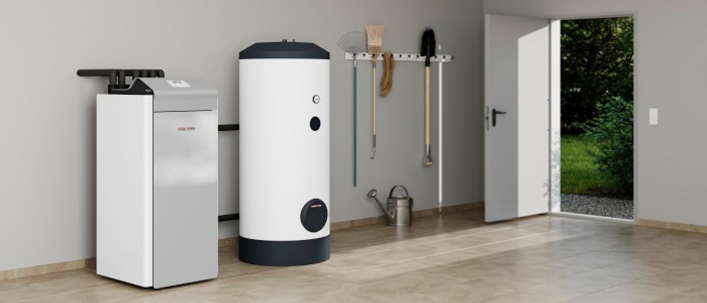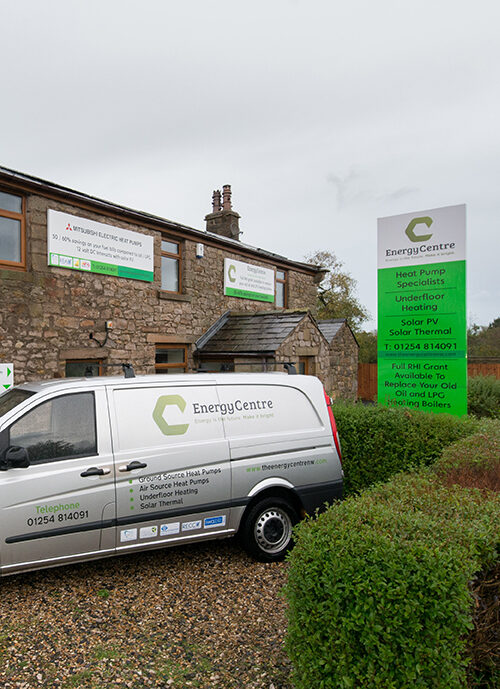
Ground source heat pumps
Ground source heat pumps (GSHPs) use pipes which are buried in the garden to extract heat from the ground. This heat can then be used to heat radiators, underfloor or warm air heating systems and hot water in your home.
A ground source heat pump circulates a mixture of water and antifreeze around a loop of pipe, called a ground loop, which is buried in your garden. Heat from the ground is absorbed into the fluid and then passes through a heat exchanger into the heat pump. The ground stays at a fairly constant temperature under the surface, so the heat pump can be used throughout the year.
The length of the ground loop depends on the size of your home and the amount of heat you need. Longer loops can draw more heat from the ground, but need more space to be buried in. If space is limited, a vertical borehole can be drilled instead.
The benefits of Ground source heat pumps
Unlike gas and oil boilers, heat pumps deliver heat at lower temperatures over much longer periods. During the winter they may need to be on constantly to heat your home efficiently. You will also notice that radiators won’t feel as hot to the touch as they might do when you are using a gas or oil boiler.
Air source heat pumps are usually easier to install than ground source as they don’t need any trenches or drilling, but they are often less efficient than ground source heat pumps. Water source heat pumps can be used to provide heating in homes near to rivers, streams and lakes
How do ground source heat pumps work?
Heat from the ground is absorbed at low temperatures into a fluid inside a loop of pipe (a ground loop) buried underground. The fluid then passes through a compressor that raises it to a higher temperature, which can then heat water for the heating and hot water circuits of the house. The cooled ground-loop fluid passes back into the ground where it absorbs further energy from the ground in a continuous process as long as heating is required.
Normally the loop is laid flat or coiled in trenches about two metres deep, but if there is not enough space in your garden you can install a vertical loop down into the ground to a depth of up to 100 metres for a typical domestic home. Heat pumps have some impact on the environment as they need electricity to run, but the heat they extract from the ground, the air, or water is constantly being renewed naturally.
Is a ground source heat pump suitable for me?
To tell if an air source heat pump is right for you, there are a few key questions to consider:
Is your garden suitable for a ground loop?
Is your home well insulated?
What fuel will you be replacing?
What type of heating system will you use?
Is the system intended for a new development?
You may also want to consider air source heat pumps, which extract heat from the outside air. Use our renewables selector to find an appropriate technology for you.
Costs, savings and financial support
Costs
Running costs will depend on a number of factors including the size of your home and how well insulated it is.
Savings
How much you can save will depend on what system you use now, as well as what you are replacing it with. Your savings will be affected by:
- Your heat distribution system. Underfloor heating can be more efficient than radiators because the water doesn’t need to be so hot. If underfloor heating isn’t possible, use the largest radiators you can. Your installer should be able to advise on this.
- Your fuel costs. You will still have to pay fuel bills with a heat pump because they are powered by electricity, but you will save on the fuel you are replacing. If the fuel you are replacing is expensive you are more likely to make a saving.
- Your old heating system. If your old heating system was inefficient, you are more likely to see lower running costs with a new heat pump. Water heating. If the heat pump is providing hot water then this could limit the overall efficiency. You might want to consider solar water heating to provide hot water in the summer and help maintain your heat pump efficiency.
- Using the controls. Learn how to control the system so you can get the most out of it. You will probably need to set the heating to come on for longer hours, but you might be able to set the thermostat lower and still feel comfortable. Your installer should explain to you how to control the system so you can use it most effectively.

